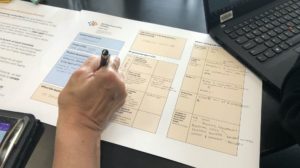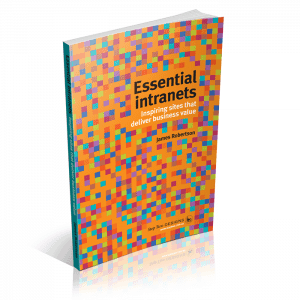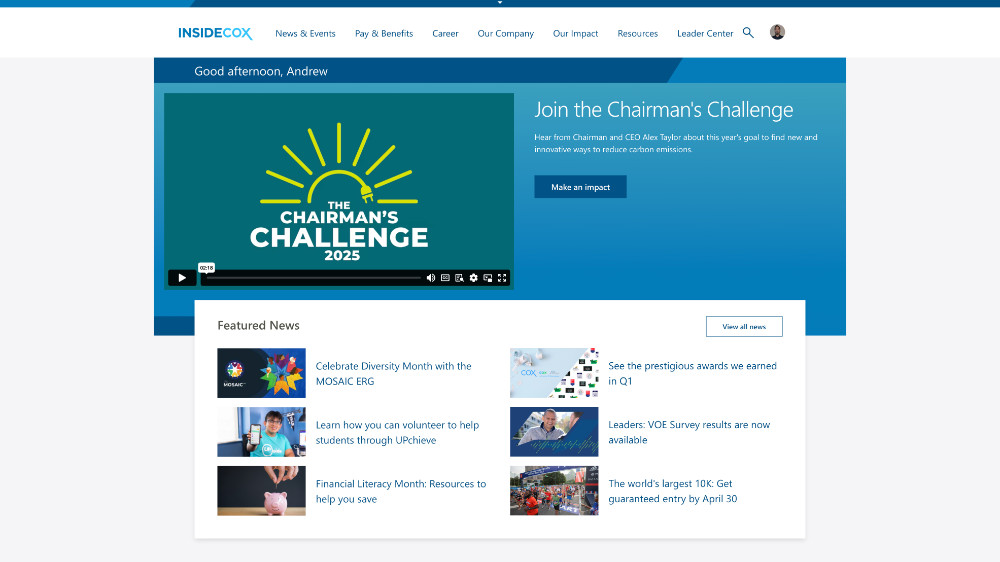
Filed under: Digital employee experience, Digital workplace, Intranet and digital workplace awards, Intranets
In 2025, intranets, digital workplaces and digital employee experience (DEX) are still making a huge difference in the workplace. Most of us spend our working day in and out of technology, so the solutions we use are incredibly important.
Intranets and digital workplaces help us stay productive and get things done. They act as the single source of truth for reference content and knowledge. They underpin core organisational processes. They help us to access the different apps across the digital workplace. They connect us with our colleagues and help to nurture organisational culture. Organisations continue to invest in digital workplace tools and technologies that deliver value in many different areas.
In the past year, generative AI has been the dominant theme in the digital workplace space. It has the potential to revolutionise the way we work, but it is still very early days. Many organisations and their employees are still finding their feet and have yet to find the true value of AI. While some of the winners in the 2025 Awards focus on AI, the majority of entries we received did not feature AI at all.
The 2025 Intranet and Digital Workplace Awards show the very latest trends in intranets and digital workplaces. They confirm that digital employee experience continues to move forward. As in previous years, we received entries from all around the world. Entries covered a full range of organisations of different sizes, from different sectors and in different territories. Significantly, the general standard of submissions remains as strong as ever.
Full details including hundreds of screenshots can be found in the Intranet & Digital Workplace Showcase report. For the first time, we’re also offering a free chapter from the Awards report, sharing the full case study from Gold winner Burger King UK. If you haven’t purchased one of the yearly Awards reports before, be prepared to be amazed at the depth of insights and scope of screenshots shared! This will give you a sense of the value of full Showcase report.
Here’s five of the key highlights from the 2025 Intranet and Digital Workplace Awards:
1. Next generation KM is already embracing AI
The rapid evolution of AI is disrupting every corner of the digital workplace. One area where AI has the potential to be a real game-changer is in the world of knowledge management (KM). AI provides opportunities to revolutionise core KM areas such as advanced findability, expert location, reusing high value knowledge assets, automating content tagging and more. There is also a symbiotic relationship between AI and KM, with the latter contributing to the essential foundations that ensure AI has value.
With the rush to exploit the value of AI, organisations that are already mature and advanced in their KM journey have a head start and are actively experimenting and innovating with AI, by applying it to key KM-related use cases.
At pharmaceutical giant Roche, the Product Development KM team has built a highly ambitious knowledge platform, branded as the Digital Workspace (DWS), which leverages AI to support a number of KM-based solutions.
These are oriented around high value use cases such as answering complex queries by involving the right experts, and mining lessons learnt and related assets for future planning. The AI is built into the core technologies that the DWS is built on, including the Sinequa search solution and the Outsystems development platform.
The team has deployed AI in different ways, including suggesting relevant knowledge assets to support hyper-personalised KM, and driving an intelligent personalised search experience that identifies expertise. As the system improves through machine learning, the team have a wider ambition to use AI to bring personalisation, at scale, to the area of knowledge delivery.
Global professional services firm, EY, already has an advanced custom knowledge platform, called Discover, that includes thousands of presentations and credentials that are used to win new work. EY has now brought generative AI to the platform through the Market Engine, a set of ambitious AI-powered apps that generate answers and output in response to user prompts, helping increase the quality of proposals and save time.
For example, the Proposal Engine retrieves assets that can be used as a starting point to build a presentation, while the RFP Answer Engine generates specific RFP responses, and can analyse a whole RFP document. These cutting-edge tools are still evolving, but the EY team continue to look ahead, particularly with the Collection Engine, which automates much of the submission process for new assets to add to Discover through an intelligent approach. This will potentially automate KM at scale, arguably achieving something of a “holy grail” for KM.
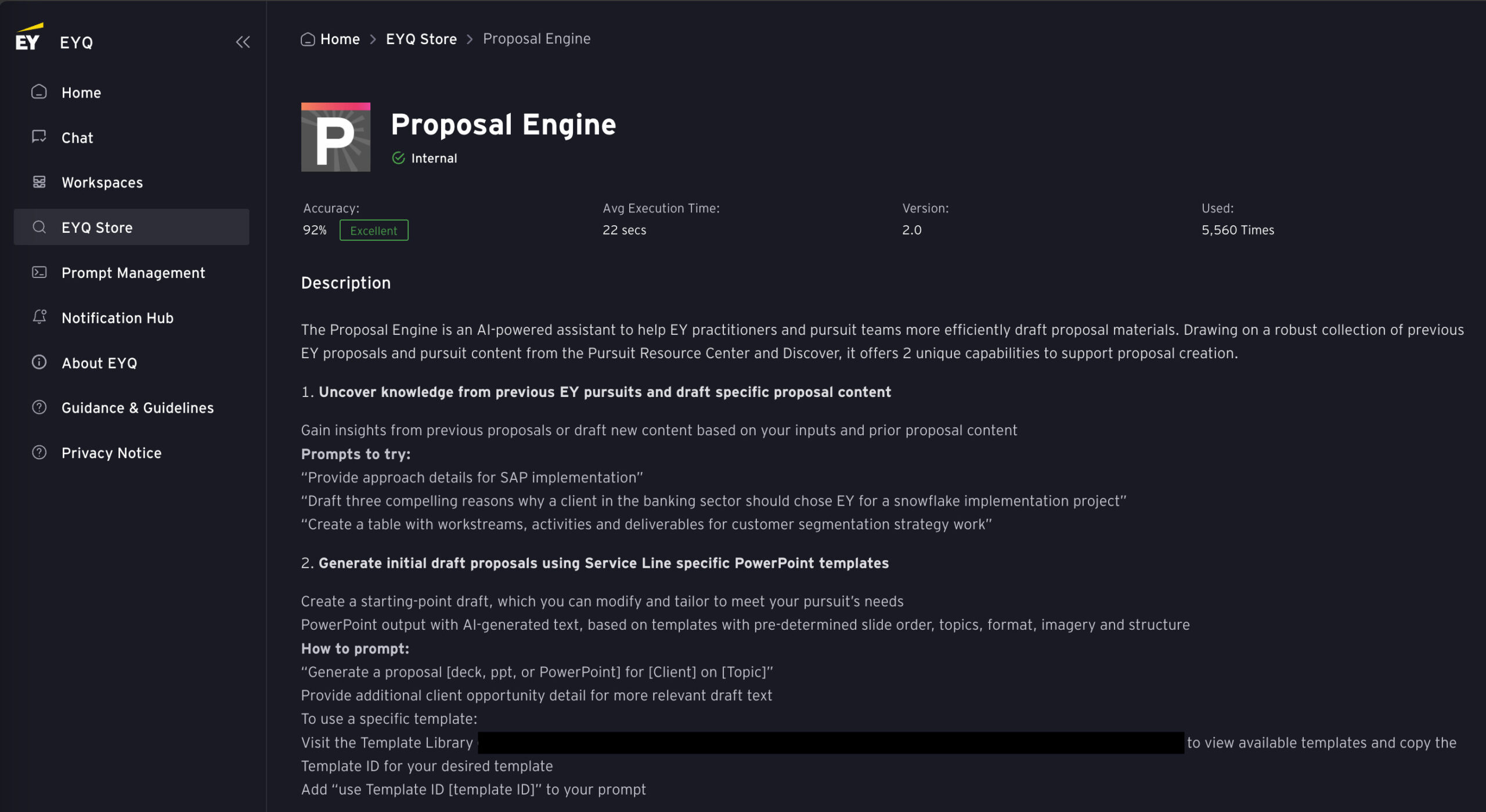
EY’s Proposal Engine, one of the four apps in the Market Engine. Screenshot appears courtesy of EY.
2. Frontline DEX drives engagement and productivity
Engaging frontline employees who work in customer-facing roles, are out in the field, or based in factories or distribution centres, is not easy. A confluence of factors makes it difficult for comms and intranet teams, such as the logistics of connecting with employees who do not have a desk, digital workplaces architected around the needs of office-based workers, and a lack of digital identities.
Those organisations that do succeed are ticking the boxes on multiple fronts. A starting point is providing effective mobile access and ensuring communications and branding are laser-focused around the needs of frontline staff. They are also providing solid reasons to visit digital channels, with features that support productivity and help frontline staff get things done.
At Burger King UK, the vast majority of staff work in restaurants, and most are under 22 years of age. Many do not have English as their first language. Traditionally engagement and communications had not been straightforward, particularly with new starters, who were sometimes dropping out before their first day. To remedy this, the company set up an intranet called BK Hub with an accompanying mobile app that is easy to install. This has seen exceptional levels of engagement and adoption amongst employees.
A mix of a high impact launch campaign, playful messaging, and strong alignment with the distinctive Burger King brand have all contributed to the success of BK Hub. An emphasis on user-generated content and a peer recognition feature also support engagement. Crucially, the intranet brings multiple process improvements, like integrations with key systems, digital forms to transform manual efforts, and auto-translation to support non-native speakers. A strong onboarding feature has even reduced drop-out rates.
At Mazda North American Operations, the team need to reach a highly complex and predominantly frontline workforce of 24,000, which encompasses employees, franchised car dealerships, suppliers and those working in field sales. Previously, there were four separate intranets or portals supporting each group, which was highly inefficient.
The team did an excellent job in creating just one intranet for this diverse group, with access to relevant content governed by permissions. The intranet has strong brand alignment, partly informed by visits to dealerships during the user research phase. Crucially the team ticked both the engagement and productivity boxes with resources that are essential for everyday frontline work. As a result, 75% of dealers and 76% of employees use the intranet every day, which is a strong adoption rate for such a challenging, distributed workforce.
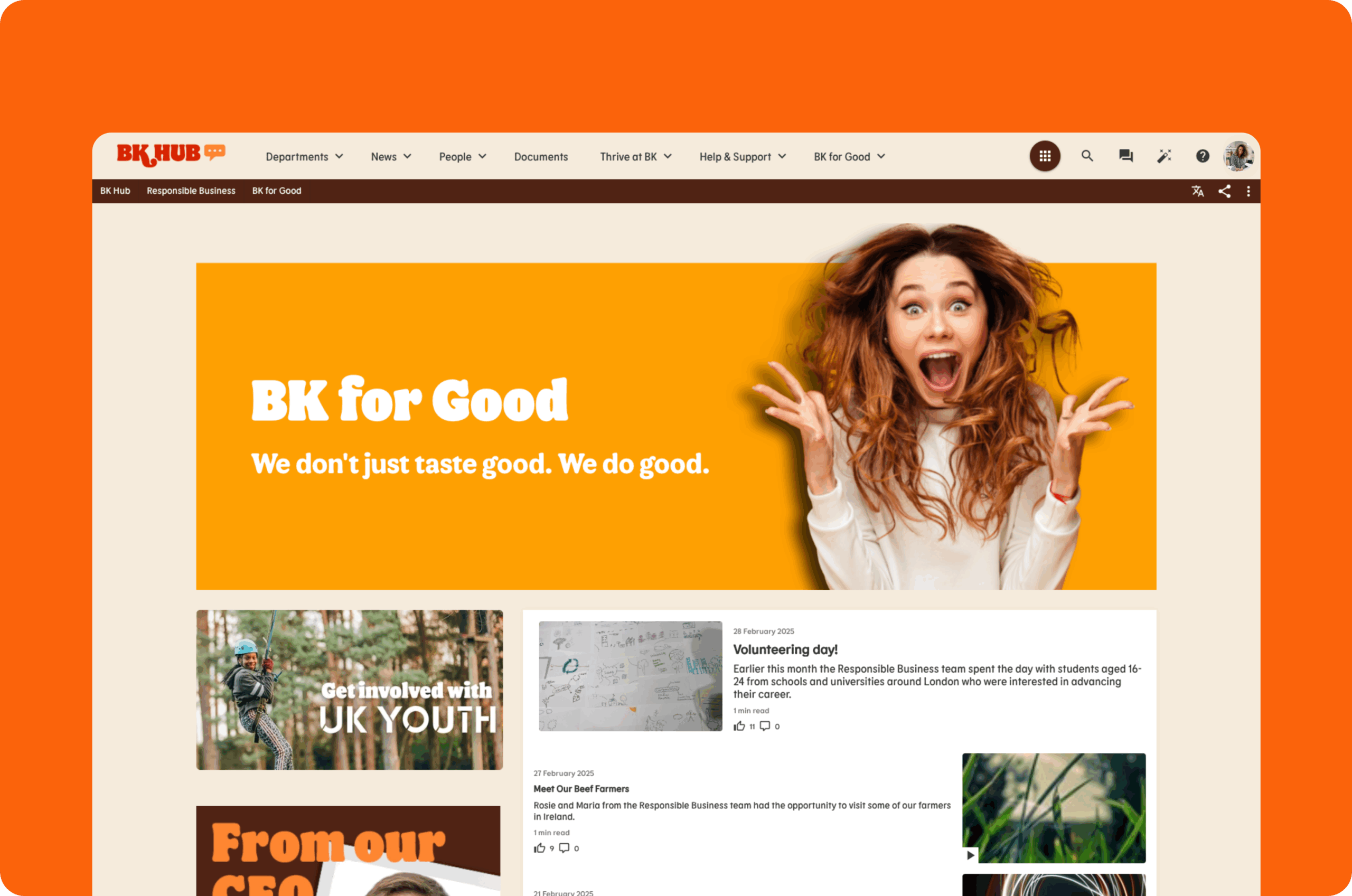
The “BK for Good” page on Burger King UK’s BK Hub intranet. Screenshot appears courtesy of Burger King UK.
3. IC teams get creative to conquer challenges
Internal communications teams make a huge difference to every organisation in driving engagement and managing change. But their job is not always straightforward and various challenges can limit what they can achieve.
There can be a lack of resources with small central teams working with restricted budgets. Limited technology and tools can prevent messaging reaching the entire workforce. Throw in complex organisational structures, legal restrictions and disconnected employees into the mix, and you have real barriers to success.
But challenges are also a catalyst for creative thinking and innovative approaches. Savvy IC teams are overcoming their challenges by applying a “can do” mindset, and coming up with ideas and workarounds that deliver effective communications.
US communications and media group, Cox Enterprises, operates across three main businesses — and three different Microsoft 365 tenants. Although the large majority of internal communications are common to all three, the different tenants present significant operational challenges. For example, IC teams have to manually repost items across each intranet.
To address this issue, the team has introduced a set of smart approaches covering the format of content, the content management process, the tone of voice, and editorial coordination. These include deploying common intranet software across all three tenants, and an innovative “content syndication” feature that allows the flow of news items across all three intranets. This smart solution uses both automation and an effective dashboard for communicators. Alongside this, a new weekly meeting across the united intranet editorial team, and common tone of voice has led to consistent and fully aligned comms, as well as a huge reduction in effort.
Over at Scottish Government, a flagship series of engagement and learning events were under threat due to spending restrictions. Usually, these events involved an external platform and partner. Instead of cancelling the event, the team made a rapid pivot and moved everything in-house, creating a hybrid event using a mix of existing digital workplace tools and their SharePoint intranet.
The pivot involved the team thinking on their feet, getting creative with new content formats, and working outside their comfort zone. This positive mindset resulted in a successful event with greater levels of reach and engagement than previous years. The platform also had better usability and accessibility, with a massive reduction in costs.
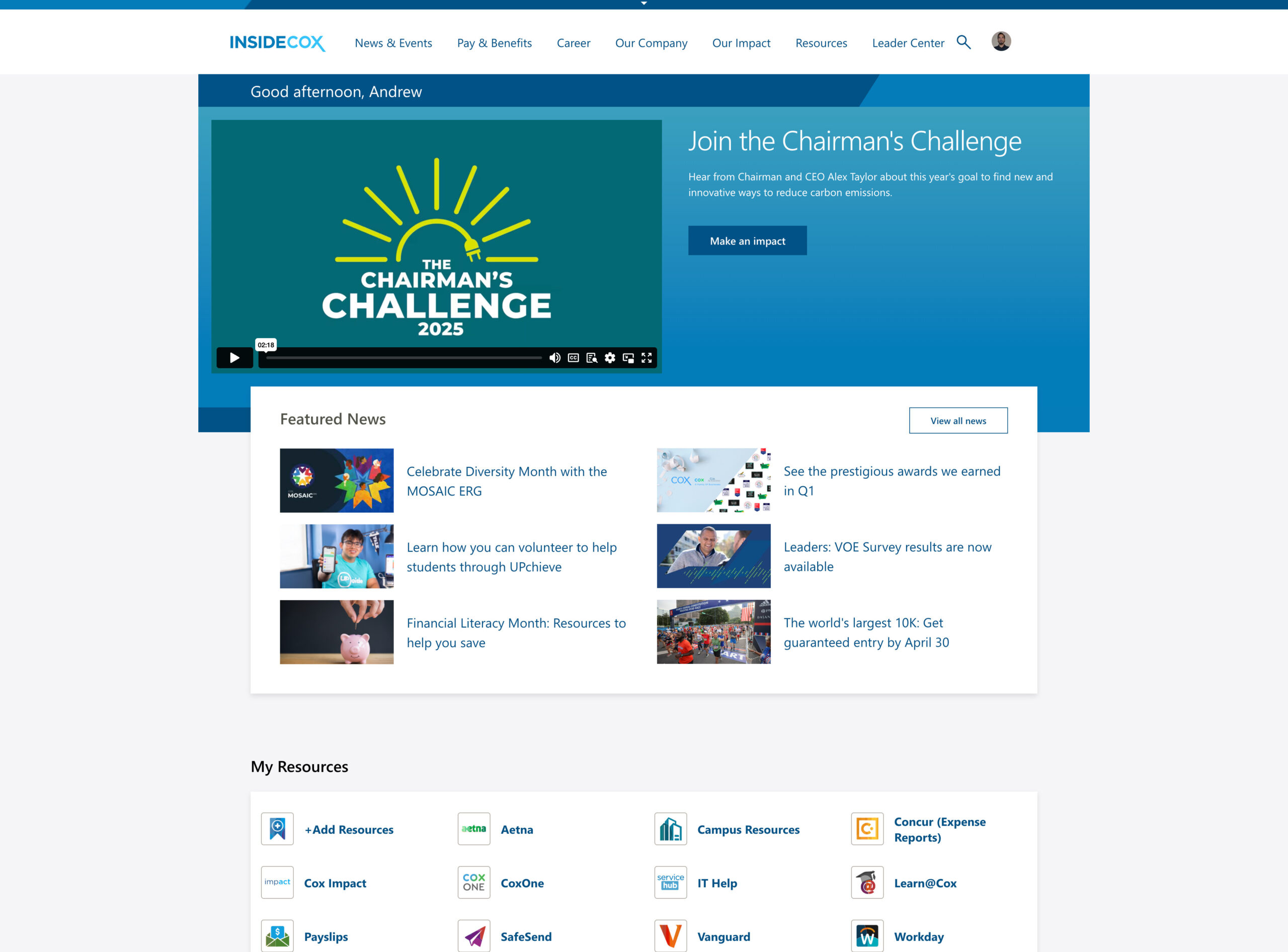
A screenshot of the CoxOne intranet homepage. Screenshot appears courtesy of Cox Enterprises.
4. Skills-based approaches supercharge adoption
For a long time, digital workplace teams have focused on improving the digital dexterity of users in order to help launch tools, drive adoption and encourage effective tool usage. Improving digital skills has never been more important as new AI tools are introduced at scale, and businesses navigate skills gaps and shortages in order to maintain competitive advantage.
In the past, digital literacy efforts have tended to lack focus and come across as somewhat “woolly”, or have just been tied to the launch of a particular tool. Savvy digital workplace teams are now taking more of a structured and strategic approach to improving digital skills and competencies, by designing programs that take in wider concepts, such as preferred modes of learning, and reference the skills that organisations need to invest in for the future.
At Australian data centre operator, NEXTDC, the team has taken a skills-based approach to improving digital literacy. They have defined the specific skills and behaviours required around two scenarios – working as a team and working with files. They have also mapped these to three different levels — bronze, silver and gold — relating to what everyone needs to know, what most people should know, and what key roles should know.
Targeting specific actions required to uplift skills has proved more tangible for users, and also allows the team to design a program based around different “modes” of learning. These include self-directed learning, peer and organisational support, and communications. The team were then able to design two proofs of concept around a sales team and a functional team, and subsequently measure success. The results are allowing them to design an organisational-wide program which will supercharge the adoption of tools, as well as informing digital workplace strategy and wider skills management.
Global law firm, Ashurst, has been an early adopter of generative AI solutions, investing in the Harvey suite of tools and rolling them out to all staff. In order to support AI-readiness and achieve ROI, the team designed a learning program to improve AI skills and confidence. The four-part course was delivered in live sessions, which were recorded and then added to Ashurst’s global learning platform.
To date, an exceptional 95% of the firm has engaged with the AI fundamentals course, resulting in an excellent 70% usage rate of AI tools across the firm. By covering skills and user confidence, the team have ticked boxes around adoption, learning and competitive advantage.
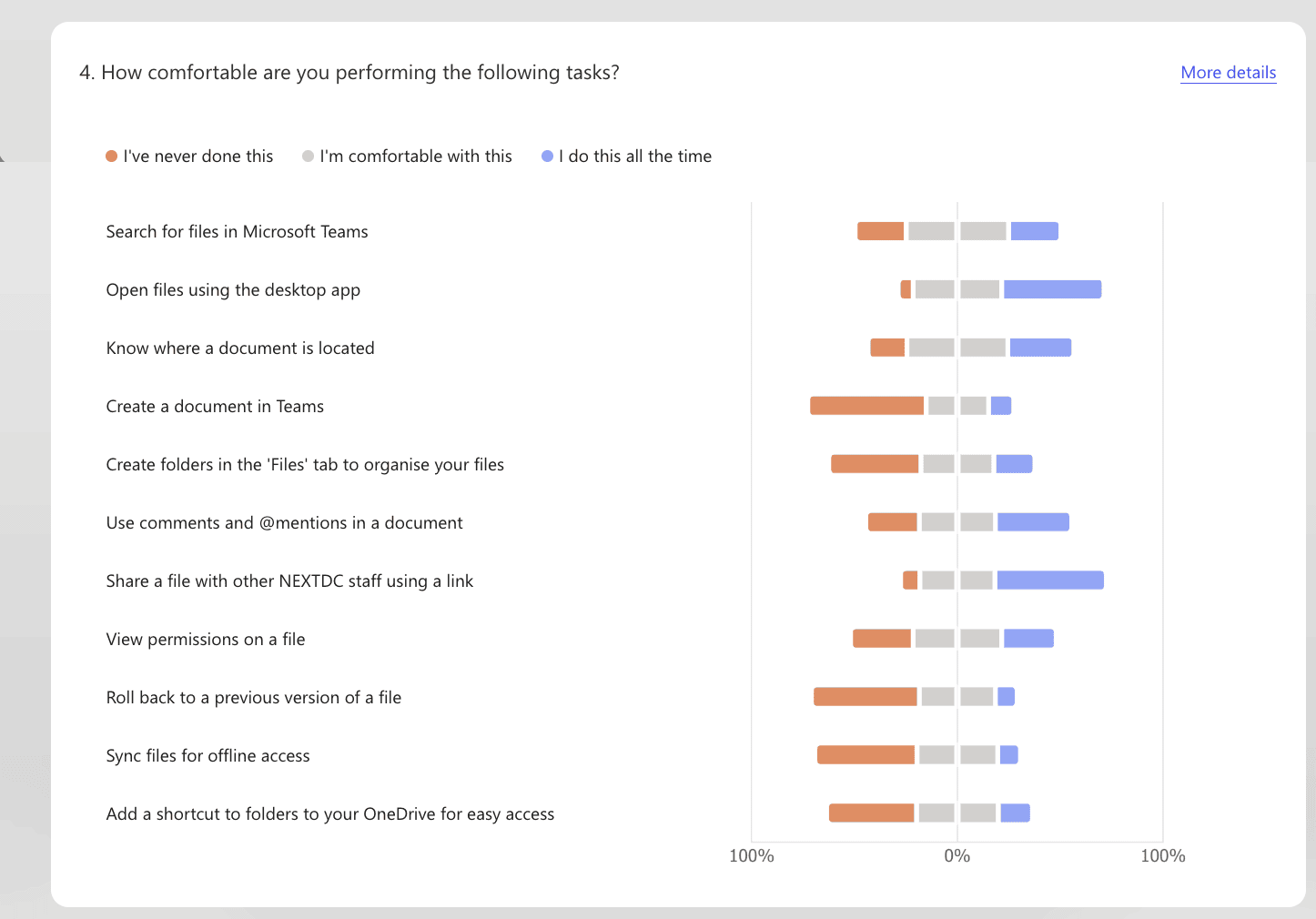
Assessment of digital skills relating to specific scenarios of use. Screenshot courtesy of NEXTDC.
5. Ecosystem evolution unlocks real business value
Successful digital workplaces evolve over time and build on what has come before. Organisations that take a long-term view of their digital workplace, and are able to gradually build a coherent, consistent, and integrated digital ecosystem, have the potential to unlock huge business value.
A more mature digital workplace, crafted in a considered and intentional way, enables teams to build features that leverage strong foundations. These include powerful integrations, data standards and storage, and consistent metadata. These features can help solve particular business problems, improve complex processes, deliver end-to-end solutions, and pave the way for the introduction of AI. Over time organisations will experience stronger adoption and ultimately get more out of their investment.
Global engineering firm, COWI, has a long record of using collaborative sites built in SharePoint to aid project management, as far back as 2008. The result is a very mature digital workplace that integrates with COWI’s core platforms, such as their ERP system and their intranet. There is one source of truth for data across the environment, making it easier to create multiple views and support reporting.
The latest innovation from COWI is built on top of this ecosystem with a series of four apps. These apps increase efficiency and reduce risks around managing both proposals and projects. The result is a toolset that supports the end-to-end process from opportunity to proposal to project.
Roche’s product development knowledge management team have established the Digital Workspace (DWS), an integrated digital environment that incorporates an enterprise search.
On top of this, they are building a set of highly ambitious, complementary knowledge and collaboration apps that seek to solve complex problems, drive efficiency and reduce risk. So far, the apps facilitate expertise location, a Q&A facility, an “Outcomes” resource for planning, and the “Automated Query Management” app that gives oversight to key questions, all high value areas. More apps are planned, with the DWS continuing to evolve to meet new challenges.
EY have also built a layer of apps on top of the valuable work that has gone before. EY’s custom knowledge platform, Discover, previously won a Gold award. The team have now built four AI-powered apps that meet specific use cases, including creating presentations and answering RFPs. The future ambitious plan is to automate much of the KM effort, again evolving an ecosystem to derive even more value
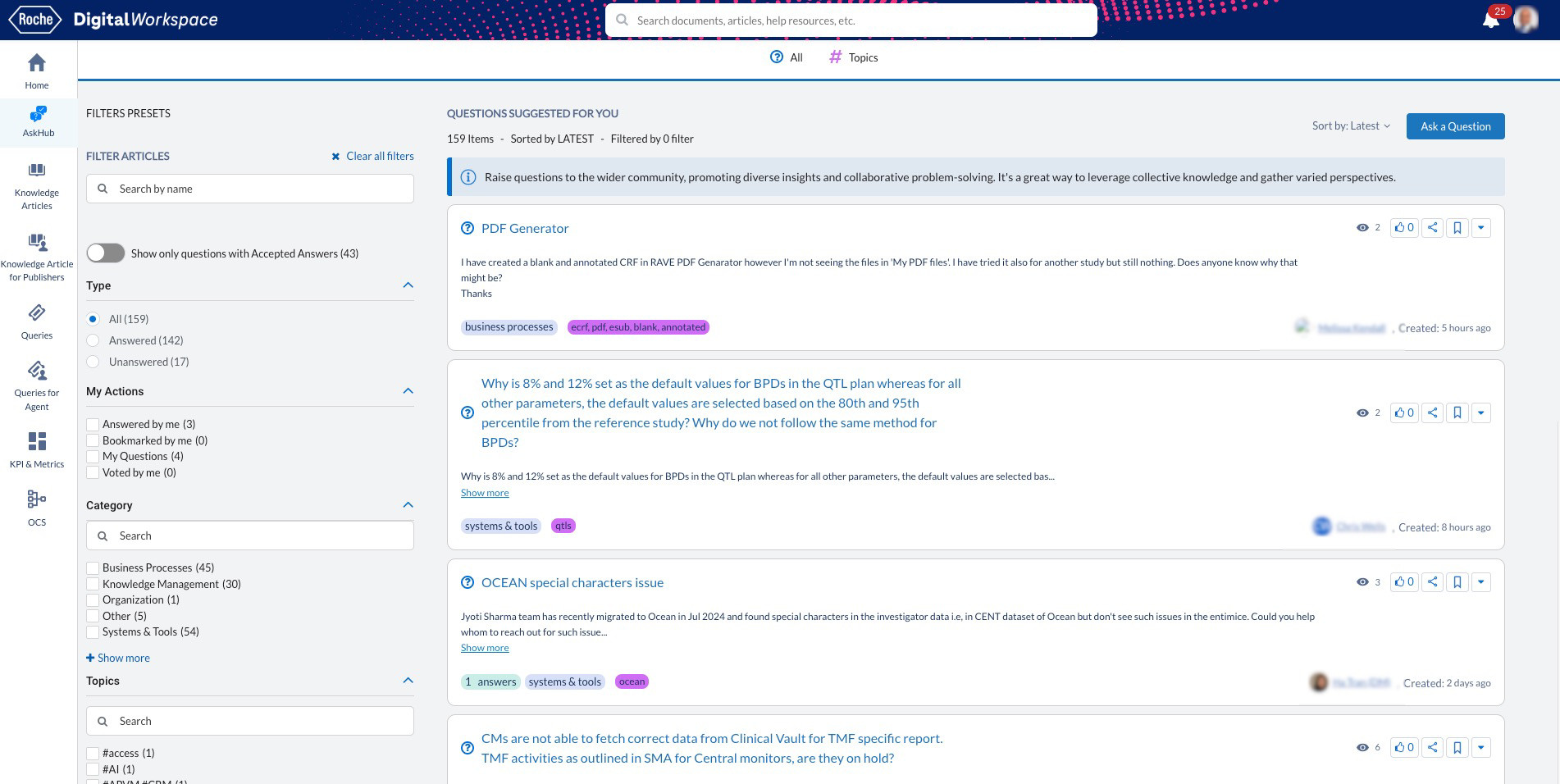
The home screen of the AskHub in Roche’s Digital Workspace platform. Screenshot appears courtesy of Roche.
Get inspiration from 12 great case studies with screenshots
The full 2025 Intranet and Digital Workplaces Showcase report features detailed case studies of all 12 winning entries, each detailed with multiple screen shots of the sites in question. At AU$299/€180/US$200 it’s exceptional value, helping to both inform and inspire intranet and digital workplace teams. Report sales also support the effort it takes us to keep on running the Awards (which have no associated fees).
If you want to get a sense of what a case study looks like, you can also download a free chapter from the Awards report, sharing the full case study from Gold winner Burger King UK.
Enter next year!
If you’re currently doing great work on your intranet or digital workplace, visit the Awards page, and sign up to be notified when next year’s Awards opens for entries in February 2026. It will also be our twentieth Awards!



